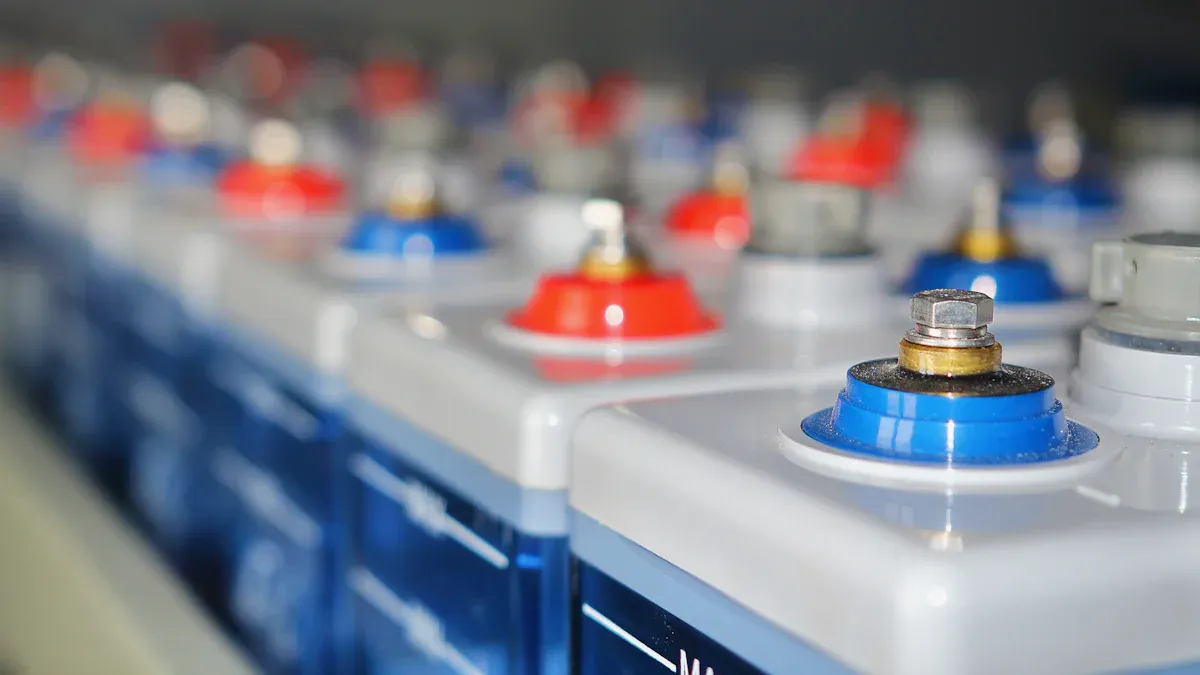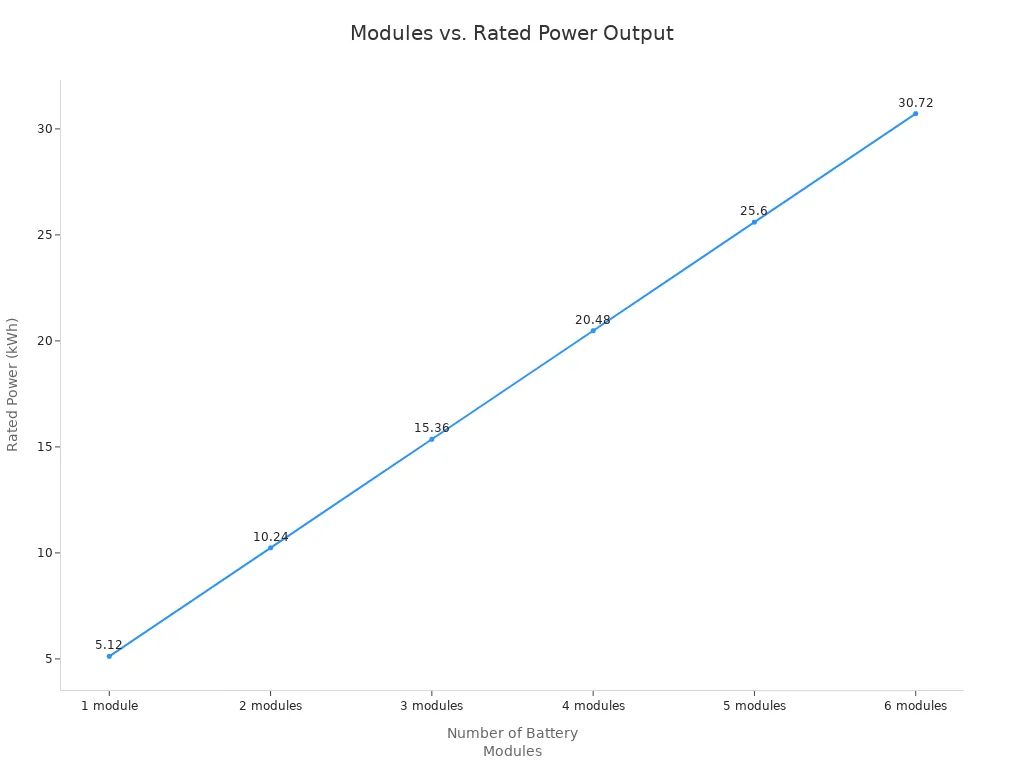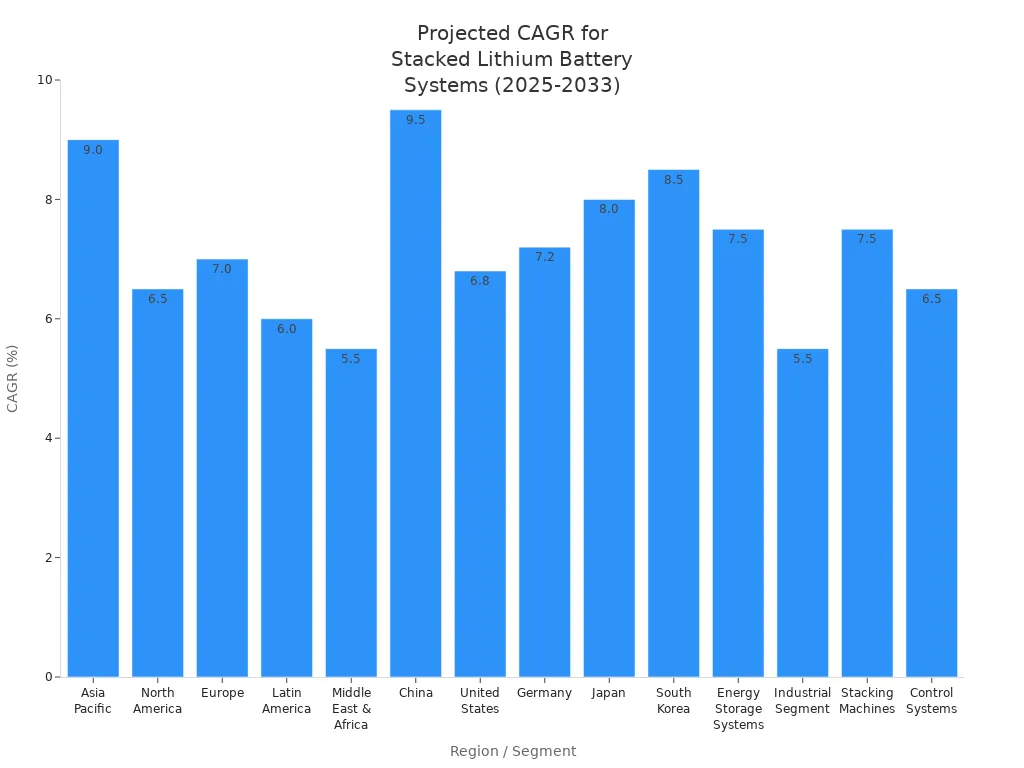
Battery stacks boost lithium power output by connecting several battery modules together, either in series or parallel. This setup increases both voltage and capacity, giving you more energy and better performance. Stacked batteries use a modular design, so you can start small and add more batteries as your power needs grow. This system keeps your energy storage flexible, space-efficient, and reliable. You also benefit from built-in safety features and easy maintenance, since you can replace or service a single battery module without shutting down the whole system.
- Modular stacked batteries offer:
- Easy expansion for growing energy needs
- Space-saving designs for tight areas
- Higher reliability and safety for your system
- Simple installation and maintenance
Battery Stacks Basics

What Are Battery Stacks
You can think of battery stacks as building blocks for energy storage systems. In the context of lithium batteries, a battery stack is a multi-layer structure. Manufacturers cut positive and negative electrode sheets to specific sizes and stack them with separators. This process creates several small battery cells, which are then welded and packaged into complete modules. Stacked batteries use this method to improve space use, energy density, and safety. The stacking process also allows for batteries with different shapes, giving you more design flexibility for your energy storage system.
When you build a stacked energy storage system, you combine several battery modules. Each module contains many cells stacked together. You can add or remove modules to match your energy needs. This modular design makes it easy to expand your storage or replace a single module if needed.
Tip: Stacked batteries offer better structural stability and longer cycle life compared to traditional winding technology.
The most common way to assemble battery stacks involves both mechanical and electrical steps:
- Place the base on the ground.
- Remove the panel, adjust the direction, and place the lithium battery layer on the base. Lock it with screws.
- Add the next layer, such as a solar inverter, and secure it.
- Use accessories to finish the installation.
- Reinstall the panel.
You also need to align the modules, use holders or frames, and apply even compression to keep everything safe and stable.
Series and Parallel Connections
You can connect battery modules in two main ways: series or parallel. Each method changes how your stacked batteries perform.
-
Series Connection: When you connect modules in series, you add their voltages together. The capacity (measured in ampere-hours, Ah) stays the same. For example, if you connect two 12V batteries with 100Ah each in series, you get 24V at 100Ah. This setup works well when you need higher voltage for your energy storage system.
-
Parallel Connection: When you connect modules in parallel, you add their capacities together, but the voltage stays the same. For example, four cells at 2500mAh each in parallel give you 10,000mAh at the same voltage. This method is best when you want to increase how much energy your system can store.
-
Combination: Many stacked batteries use both series and parallel connections. This combination lets you reach the voltage and capacity you need for your application.
Here’s a quick comparison:
| Connection Type | What Increases? | What Stays the Same? | Example |
|---|---|---|---|
| Series | Voltage | Capacity | 4 × 3.7V = 14.8V, 2500mAh |
| Parallel | Capacity | Voltage | 3.7V, 4 × 2500mAh = 10,000mAh |
Note: Series connections are often preferred for stable electrical output, especially in automotive and large energy storage systems. Parallel connections can make the system more complex, but they help increase reliability and safety.
Voltage & Capacity
Stacked batteries let you boost both voltage and capacity, depending on how you connect the modules. When you add more modules in series, the total voltage of your battery stack goes up. The capacity stays the same, but you get more power for devices that need higher voltage. For example, connecting six modules in series can give you a much higher voltage, which is useful for large energy storage systems.
When you add modules in parallel, you increase the total capacity. This means your system can store more energy and deliver more current. You can start with a small stack and add more modules as your energy needs grow. This modular battery solution makes it easy to expand your storage without replacing the whole system.
The relationship between the number of stacked modules and total power output is direct. As you add more modules, you increase both the rated power and the maximum charge/discharge current. The following table shows how stacking more modules increases the system’s capacity and power:
| Number of Battery Modules | Rated Capacity (kWh) | Rated Power (kWh) | Max Charge/Discharge Current (A) |
|---|---|---|---|
| 1 | 5.12 | 5.12 | 100 |
| 2 | 10.24 | 10.24 | 200 |
| 3 | 15.36 | 15.36 | 300 |
| 4 | 20.48 | 20.48 | 400 |
| 5 | 25.60 | 25.60 | 500 |
| 6 | 30.72 | 30.72 | 600 |
You can see that as you add more modules, the system’s capacity and power output increase. This makes stacked batteries ideal for applications where you need to scale up your energy storage system over time.

Stacked energy storage systems use advanced battery management systems to balance charging and discharging across all modules. This keeps your system safe and efficient as you expand. The modular design also makes it easy to test, repair, or upgrade your storage as your needs change.
Remember: Stacked batteries give you the flexibility to build an energy storage system that grows with you. You can start small and add more modules as your energy needs increase.
Key Components in Batteries

Battery Modules
You will find that battery modules form the building blocks of every lithium-ion phosphate battery stack. Each module contains several lithium-ion cells connected in series and parallel. This design lets you reach the voltage and capacity you need. For example, 4s lithium-ion phosphate modules use four cells in series to boost voltage. You can combine these modules to build larger lithium-ion phosphate battery packs.
Modules often include their own battery management systems and cooling features. This setup helps you monitor and balance each cell. The modular design makes it easy to scale your system. You can add or remove modules as your energy needs change. Maintenance becomes simple because you can replace a single module without touching the rest of the batteries.
A typical lithium-ion phosphate battery stack includes:
- Lithium-ion cells for storing energy
- 4s lithium-ion phosphate modules for voltage control
- Passive components like bus bars and fuses
- Enclosures for protection
- Thermal management systems for temperature control
You will see that modular batteries support automation and high production quality. They also make upgrades and repairs much easier.
BMS
The battery management system, or BMS, acts as the brain of your lithium-ion phosphate battery. It checks the voltage, current, and temperature of each cell in your modules. The BMS balances the charge across all cells, which keeps your batteries safe and extends their life. In 4s lithium-ion phosphate modules, the BMS ensures that each cell charges and discharges evenly.
You can rely on the BMS to prevent overcharging, overheating, and deep discharging. It also communicates with other systems to report battery health. The BMS manages the charging and discharging rates, which protects your lithium-ion phosphate battery from damage. You get more usable capacity and longer battery life with a good BMS.
Thermal Management
Thermal management keeps your lithium-ion phosphate battery at the right temperature. You need this system to prevent overheating and to keep your batteries working well. Common methods include air cooling, liquid cooling, and passive cooling. Some lithium-ion phosphate batteries use phase change materials or advanced thermal interface materials to move heat away from the cells.
The BMS also helps with thermal management by adjusting how fast your modules charge or discharge. Good thermal management means your 4s lithium-ion phosphate modules stay safe and last longer. You can trust these systems to keep your lithium-ion batteries running smoothly, even when you add more modules to your stack.
Tip: Always check that your lithium-ion phosphate battery stack has proper thermal management. This step protects your investment and ensures reliable performance.
Benefits of Stacked Batteries
Scalability
You can easily expand your energy storage system with stacked batteries. The modular design lets you add more modules as your needs grow. This approach gives you a scalable solution that fits both small and large projects. You do not need to replace the whole battery when you want more capacity. Instead, you simply add another module. This method saves time and money.
Here is a comparison between stackable modular batteries and traditional single-module batteries:
| Parameter | Stackable Modular Batteries (e.g., 2×100Ah) | Traditional Single-Module Battery (e.g., 1×200Ah) |
|---|---|---|
| Capacity Expansion | Incremental and seamless by adding modules | Limited; often requires full replacement or complex upgrades |
| Redundancy | High; one module can maintain power if another fails | Low; single point of failure |
| Maintenance | Modules can be serviced or replaced individually, reducing downtime | Entire unit must be serviced or replaced |
| Thermal Management | Better heat dissipation due to smaller, distributed modules | More challenging due to larger single unit |
| Battery Management System | Distributed BMS per module allows granular control and safety | Single BMS with higher complexity and risk of system-wide failure |
| Cost Efficiency | Lower initial investment with staged expansion possible | Higher upfront cost; less flexible for future growth |
Stacked batteries give you modular scalability, making them a top choice for scalable energy storage.
Reliability
Stacked batteries offer strong reliability for your energy needs. If one module fails, the rest keep working. This fault isolation means your system stays online even during maintenance. You get longer cycle life and better performance compared to single large batteries. Stacked batteries also improve thermal management, which helps prevent overheating.
- Stacked batteries cycle over 300 times, showing longer life.
- The design improves power capability and keeps temperatures stable.
- Fewer external connections reduce the chance of system failure.
- You can add or remove modules without shutting down the whole system.
- These batteries charge quickly, run quietly, and need almost no maintenance.
You can trust stacked batteries to deliver dependable energy for many years.
Efficiency
Stacked batteries bring improved efficiency to your energy storage system. The special design lowers internal resistance by up to 15%, so you lose less energy as heat. Each module shares the current evenly, which helps your batteries last longer and work better. You also get better space use, with up to 95% of the space filled by battery cells.
- Multi-tab parallel electrodes in stacked batteries lower resistance and boost efficiency.
- Even current flow across modules means less voltage drop and better performance.
- Good heat management keeps temperature changes under 3°C, protecting your batteries.
- The compact design lets you store more energy in less space.
With stacked batteries, you get improved efficiency, longer battery life, and reliable performance. This makes them a smart choice for anyone who wants a scalable solution for energy storage.
Stacked Energy Storage System Uses
Renewable Energy
You can use a stacked energy storage system to support renewable energy systems like solar and wind. These batteries store extra energy when the sun shines or the wind blows. Later, you can use this stored energy when you need it most, such as at night or on cloudy days. Stacked batteries help balance the flow of energy, making your power supply more stable and reliable. You can expand your storage as your needs grow, which makes these systems perfect for both small homes and large solar farms. Many people choose stacked batteries for residential energy storage because they offer flexibility and easy upgrades.
Tip: Stacked batteries work well with renewable energy systems, helping you save money and reduce your carbon footprint.
Commercial & Industrial
You will find stacked energy storage systems in many commercial energy storage and industrial settings. Factories, warehouses, and microgrids use these batteries to meet high power demands. Companies assemble battery cells in series to boost voltage and in parallel to increase current capacity. This setup lets you build large systems that can store and deliver a lot of energy. Battery management systems (BMS) keep each cell safe by balancing voltages and controlling temperature. Cooling systems, like air or liquid cooling, help maintain the right temperature for the batteries. You can place these systems in containers or building enclosures, making them easy to install and expand. Safety features, such as ventilation and fire protection, keep your energy storage system running smoothly.
Stacked batteries in commercial and industrial energy storage systems give you:
- High power output for big machines
- Reliable operation with built-in safety
- Easy expansion for growing businesses
Backup Power
A stacked energy storage system gives you strong backup power for your home or business. These batteries keep your lights and appliances running during outages or emergencies. You can trust them to work with solar panels or wind turbines, making your energy supply more secure. Stacked batteries, especially those using LiFePO4 chemistry, offer long cycle life and high safety. The modular design lets you add more storage as your needs change. Battery management systems protect each cell and make sure your backup power stays safe and efficient.
Here are some key benefits of stacked batteries for backup:
- Reliable power during blackouts
- Long-lasting and safe operation
- Easy to expand and customize
- Good performance in cold weather
- Space-saving design for small rooms
You can count on stacked batteries to provide dependable backup and support your residential energy storage needs.
Battery Stack Challenges
Cost
You may notice that stacked lithium battery systems offer flexibility, but cost remains a key challenge. The price for a 25 kWh lithium-ion battery can range from $8,000 to $15,000, with many systems costing about $12,000. Stacked batteries let you start small and add more modules as your needs grow. This approach helps you avoid spending money on unused capacity. Over time, you can save money because you only pay for what you need. Factors like raw materials, manufacturing, and market demand affect the final price. The modular design also makes maintenance easier, which can lower your long-term costs.
Compatibility
When you build a stacked battery system, you must make sure all modules work well together. Different brands or models may not connect properly. You need to check that the voltage, capacity, and communication protocols match. If you mix incompatible batteries, you risk poor performance or even damage. Always follow the manufacturer’s guidelines for adding new modules. This step keeps your battery system safe and efficient.
Safety
Stacked batteries come with safety risks you should not ignore. Fire and explosion hazards can happen if batteries overheat or get damaged. You can reduce these risks by following these steps:
- Store batteries in cool, dry places at room temperature.
- Install fire extinguishers, fire-rated doors, and ventilation systems.
- Charge batteries according to the manufacturer’s instructions.
- Test and inspect batteries often to catch problems early.
- Remove and safely dispose of damaged batteries.
- Train everyone who handles batteries on safety and emergency plans.
- Create an emergency action plan for fire or other incidents.
Thermal runaway, which can cause fires, often starts with overcharging or overheating. Good thermal management and regular checks help keep your battery system safe.
Note: Stacked batteries need special care during maintenance. You may have to unstack modules to reach the one that needs service. This process takes more time than with single-module batteries, but the modular design still lets you replace only the faulty part. Lithium-ion batteries offer longer cycle life and higher efficiency than lead-acid batteries, making them a reliable choice for long-term use.
| Feature | Lithium-ion Batteries | Lead-acid Batteries |
|---|---|---|
| Cycle life | 3,000–6,000+ cycles | 500–1,000 cycles |
| Maintenance | Low | High |
| Efficiency | 90–95% | 70–80% |
You boost lithium power output with stacked batteries by combining modules for higher voltage, greater capacity, and strong reliability. Stacked batteries give you flexibility, easy upgrades, and dependable performance for homes, businesses, and renewable energy. Many industries now rely on stacked batteries for efficient energy storage. The market for stacked batteries is growing fast, with a 15–20% annual increase expected in the next five years.  You can expect the future of stacked batteries to bring even more innovation, supporting a cleaner and smarter energy system.
You can expect the future of stacked batteries to bring even more innovation, supporting a cleaner and smarter energy system.

FAQ
How do you safely expand a battery stack?
You can safely expand your battery stack by adding compatible modules from the same manufacturer. Always follow the instructions in your user manual. Check that the voltage and capacity match before connecting new modules.
What happens if one battery module fails?
If one module fails, your system keeps working. The other modules continue to supply power. You can replace the faulty module without shutting down the whole stack.
How often should you check your stacked batteries?
You should check your stacked batteries every month. Look for signs of damage, swelling, or overheating. Use your battery management system to monitor performance and catch problems early.
How long do stacked lithium batteries last?
Stacked lithium batteries usually last 8–15 years. You get longer life if you avoid deep discharges and keep the batteries cool. Regular maintenance helps extend their lifespan.
Tip: Always follow the manufacturer’s care guidelines to get the most out of your battery stack.

